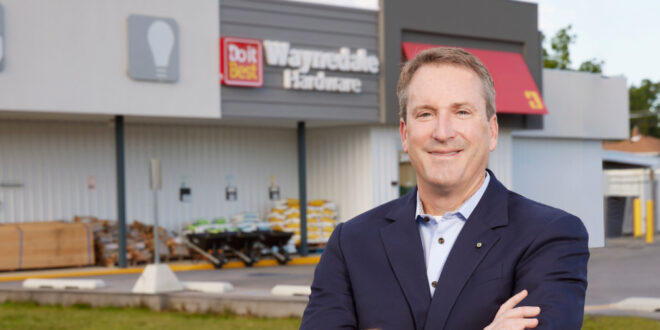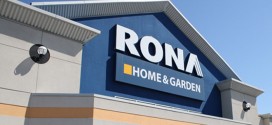 In response to Monday’s announcement that Do it Best is entering into an agreement to purchase the assets of True Value Company (pending the outcome of True Value’s Chapter 11 Bankruptcy filing on Oct. 14th), Hardware Retailing’s editorial team sat down for an extensive interview with Do it Best president and CEO Dan Starr, who did a deep dive into the plan moving forward if the deal goes through.
In response to Monday’s announcement that Do it Best is entering into an agreement to purchase the assets of True Value Company (pending the outcome of True Value’s Chapter 11 Bankruptcy filing on Oct. 14th), Hardware Retailing’s editorial team sat down for an extensive interview with Do it Best president and CEO Dan Starr, who did a deep dive into the plan moving forward if the deal goes through.
We discussed everything from what assets Do it Best is actually purchasing, to the logistics of how it will work bringing 4,500 True Value retailers into the Do it Best fold, to what it will mean for both True Value and Do it Best retailers moving forward.
Hardware Retailing (HR): Exactly what are the tangible assets that Do it Best plans to purchase? The brand? The paint facility? Inventory?
Dan Starr (DS): The main factors that make this acquisition and asset purchase sensible for us are primarily the inventory, trademarks and trade names. It’s a complicated question when you get into leases. As I understand it, that paint facility is not an owned piece of real estate with improvements. It is a lease interest that they have, so the assets that we’re buying are primarily the inventory within their various warehouses and their trademarks that include not only the corporate True Value name, but also their house brands, whether that’s EasyCare paint or Master Mechanic Tools and others. Those are the assets that are really and truly owned that we want to purchase.
We are in an evaluation process with respect to all the real estate leases, and the bankruptcy process gives anyone the right to assume or reject certain contracts. So we have to go through an evaluation process of what’s being actually demanded out of that warehouse and whether or not it makes sense. True Value is already in the process of closing down two out of the 12 warehouses that they operate, so we don’t have any firm conclusions because the process just started.
HR: So True Value’s paint facility in Carey, Illinois, is not of interest? Or is it on the table?
DS: We certainly want the EasyCare brand, and I know we’re going to evaluate the paint manufacturing assets themselves to the extent of what equipment is owned or leased. We need to detail that out so we can continue to supply True Value members with EasyCare paint. We don’t have any firm conclusions about that yet except the product. If the deal is consummated, we would own the formulas. So we would need to be able to produce the paint. Where it’s manufactured becomes the question, and it may be that the existing paint facility is the best place to do it.
HR: What is your plan to onboard 4,500 True Value retailers into the Do it Best pipeline? Are True Value retailers going to become members of Do it Best? If not, will this represent a new era for how Do it Best manages doing business with both members and non-members?
DS: You probably know that the vast majority of folks we do business with as customers is through the co-op. But you may not know that there are a number of customers we do business with who are not members of the co-op, particularly in the international sphere. So it’s not really breaking new ground that we would sell to a non-member. That already happens. It will be solved by the needs and wants of the individual independent. If they just want to be a customer and don’t want to be a member of the co-op, they don’t need to become a member. But we’re not changing who we are as an organization. We are a co-op, and we exist for the benefit of our members. I think many True Value retailers do have an interest in becoming a co-op member. It might even be the majority of them. There’s a very strong case that can be made that the co-op model was good for them historically, and they can see that it would be good for them moving forward to become a member of Do it Best, but continue to use the True Value brand.
HR: Many True Value retailers are curious about what happens to the 30% share they own in the company and if their stock will follow them into a relationship with Do it Best?
DS: That’s a great question, and there is a part of it that I can speak to, but that’s a hard question to resolve. What they have is an ownership stake in the True Value entity that just filed Chapter 11 bankruptcy. What that means is you have a trustee appointed to care for all the concerns of the various creditors, and you’ve got both secured creditors, a syndication of banks who have major claims that need to be satisfied and a huge group of trade creditors. Then there are additional unsecured creditors, and some of that’s trade credit from folks who have performed services for them. It’s going to be harder for them. This is the order of priority for any kind of corporation where you have secured creditors and unsecured creditors.
At the end of the line are the shareholders, and that’s two groups of people: There’s ACON Investments, which is the majority shareholder that owns 70% of the company, then there are the True Value retailers who own 30%. Let’s assume for the sake of argument that our bid goes through and we’re able to close on the purchase of the assets. In exchange we have the purchase price ($153 million) that then goes into the bankruptcy estate, which then becomes somebody else’s job to determine how those funds are allocated to satisfy those various claimants. We really don’t have a role there, and I don’t know how that’s going to be broken up. But from the bankruptcy filing itself, True Value has assets that range anywhere from $100 to $500 million and liabilities that range anywhere from $500 million to $1 billion.
I think it’s a very appropriate question for them to ask. But when you look at it and know that even the creditors aren’t going to come out of this whole, while I don’t know the answer, it doesn’t look great for those 30% shareholders.
HR: With the 4,000 Do it Best members you currently have and plans to bring in 4,500 True Value retailers, there’s bound to be some overlapping markets where you’ll have both True Value stores and Do it Best retailers. How will you address that?
DS: In some of those same markets there may already be another home improvement retailer and probably an Amazon warehouse within about 40 miles. There’s no shortage of competition. Let’s first clarify what we’re talking about in terms of competition that exists in their local markets, because they have larger concerns around competition than one another. We’re talking about stores that are already in existence, we’re not adding competition. We’re adding members that are already in those markets, and hopefully we can make them all stronger. With many of them flying the True Value flag, they’re already differentiating themselves. So the key to that question, more than anything else, is how do you enable them to continue to differentiate in those markets? I think that is the strength of what the brand acquisition can deliver to us—the ability to offer private-label products and unique programs that differentiate them from the local competition. That is how we see them, not just surviving but thriving and growing.
HR: One comment we’ve heard this week came from a Do it Best member who was excited about possibly leveraging the True Value brand? Will this be something that a current Do it Best member will be able to leverage?
DS: The fact that they’re even asking that question is interesting. I think that’s one of the great opportunities that we have in front of us. First of all, we have to have a path where it makes sense to offer up to any of our members the ability to use the brands that we have, and that could be the Do it Best retail brand or it could be the True Value retail brand. We want a clear path to be able to do that. However, I just spoke about the fact that they can differentiate because they have a stable of exclusive brands that they offer, such as EasyCare paint and Master Mechanic tools. We don’t have stock of that inventory everywhere, it’s in True Value’s distribution network at this time. The other is a very complex question of supply chain management, which may become a temporary limiter in how we sort through that. We can’t just say, “There’s the brand, we’ll figure out the supply chain later.” No, we’re talking about hundreds of millions of dollars of product in different places to be able to support those stores in the right way.
I can tell you that theoretically, one of the big assets that we wanted to acquire was the True Value brand to be able to support it, grow it and strengthen it. Making that available where it makes sense to Do it Best members who want to change how they go to market are great options for us to pursue. I think the only reason why we would delay the ability to do that, in the event that we close on this deal, is so we can figure out all the logistics first and make sure that they’re being supported in the right way. After that happens, I think you’ll see very clear communication around how that can occur.
HR: What about things like True Value’s True Blue assortments and planograms? Is there going to be a merging of merchandising strategies?
DS: There absolutely has to be a merging of the strategy. We have to have a strategy that covers the entire gamut. If I’m projecting, I think what you’ll find at the end of the day is there will be some unique SKUs to True Value branded stores and there will be some unique SKUs available to Do it Best members, then a common set of SKUs available to all members. It’s the common assortments where it makes sense to grow as much as you possibly can for efficiencies of scale. I don’t think I’m giving away any kind of intelligence by sharing that in hardlines distribution, you want your core that serves both groups to be as broad as you possibly can. That’s what we’re going to work on. But I still see unique SKUs for both of those parties that must be part of the mix.
HR: What about the use of True Value’s current technology for things like ordering and EDI. Do you plan to retain the technology that True Value is currently using? Or do you see an opportunity to consolidate that with what you’re currently using?
DS: EDI is an interesting example because we already use that same technology. But in terms of overall core systems, we need to consolidate that and integrate those pieces. If the deal is consummated, we would need to integrate all of the core financials and the software that runs them into one. I don’t think that happens on Day 1, but we have a plan to reconcile those. Warehouse management is another good example. Those things need to come under one house. If you’re just going to maintain separate systems, why do the acquisition in the first place? You’re not getting any benefit from the operating scale. You have to get that return on investment by making sure that you are running as lean and as consistently as you possibly can, operationally. That’s our goal. It won’t happen overnight. I think there’s some things that we can do relatively quickly while others, primarily product and logistics, are just going to take a while.
HR: Throughout the years True Value was committed to national advertising and national branding programs. While they had backed away from that somewhat in the last 5 to 10 years, is that something you are going to continue to support on a national level with national advertising campaigns?
DS: The answer to that is a qualified “Yes.” And I only qualify it because the world has changed in the meantime. Radio has changed and television advertising has changed. You’ve got streaming services and all these other things today. So even if you are convinced it’s the right thing to do, would you do it in the same way today that they did 25 years ago? Probably not. Having said that, the True Value brand is a national brand, and you need to support it the right way, which would be our intent. I think all those things are on the table, but how do you do that in the most effective means becomes the question, whether it’s using it for Google search results or for social and digital media. Those are things that didn’t exist 30 years ago, but they do now. If you’re going to own a national brand, you need to support it as a national brand, and that could mean lots of different things from an advertising standpoint which we will be evaluating.
HR: What about buying markets? If the deal goes through will Spring of 2025 be a combined Do it Best/True Value market?
DS: Ultimately, I see us having two shows a year. But that doesn’t answer the question about what to do in the spring of 2025. The lead times and the prep work for markets is significant. So, first, we have to close on this transaction. Assuming we do that as fast as we can by the end of this calendar year, our spring market is in March, so it would be unlikely that we would have a combined market in the spring of 2025. I’d love to, but I think it’s a little faster paced than we can realistically move. It’s possible in the fall of 2025, but even that is going to take a Yeoman’s effort. Our intent will be to go as quickly as we can to integrate and have two markets a year. Having all these independents together, to me, that’s the ultimate goal—harnessing the power of that many independent retailers getting together in one area and what we can gain by sharing from one another, getting to know one another and expressing their purchase volume together. All those things would make the market so much more powerful. We’re going to move as quickly as we can into one show for both groups, but two shows a year is where we’ll end up.
HR: Will there still be a standalone show for True Value next spring?
DS: We haven’t made any hard and fast conclusions on that, but given the timeline constraints, I would not be surprised if we stage and execute on the Reunion that they have planned for the Spring of 2025. We can use that as an opportunity to share some of the future plans with them.
HR: Assuming the deal will close, what do you foresee as the biggest challenges that you have to address right away?
DS: Ensuring that during the bankruptcy proceedings, product returns to their warehouses so we can get it out to the retailers. We want to make sure that independent retailers relying on True Value as a primary source of supply encounter no disruption. I want to make sure to improve the execution that they get from an ordering availability, fill rate and delivery standpoint. Those fundamentals need to be addressed first, and the folks in leadership positions here, myself included, need to have an appreciation and understanding of how their operations work. You can’t integrate those pieces until you truly understand those things, and it will require working with some of the True Value team and making sure that we’re working together to understand and improve those operations. Then we can get to the hard work of integration through a staged out, sequenced process that makes sure that we have reliability and no disruption. We want to make sure that we are taking the right steps to ensure the continued viability and growth for 4,500 independent True Value retailers across the U.S. whose future would otherwise be in doubt.
HR: When you say there needs to be ongoing cooperation between the existing True Value team and Do it Best, is there a plan to move people from True Value into the Do it Best team in the short term?
DS: We’re really in the developmental phase, but that’s our goal and we’re still developing those plans for both execution as well as integration. We’re just not at a point where we can finalize those plans because we’re not a part of their operation yet, and we can’t jump over the bankruptcy process and start working with their employees. Going back to our approach, we’re going to get our arms around the operations with the help of True Value folks. We’re not going to try to smash it all together without a whole lot of thoughtful planning.
HR: What are some of the other synergies that you are excited about?
DS: Negotiation synergies with the vendor community through the consolidation of programs is one. We’ve also got the critically important synergy of how many miles you travel per load, and what that means when you get a greater density of membership across the U.S. so you can drive distribution efficiency. You’ve got the synergy of warehouse optimization efficiency, given that you’ve got different footprints and different locations. Then you have other synergies that are service oriented, such as the marketing, the branding support and the education that we offer to our membership.
Why spend the same money that True Value has historically spent when we’re both doing some of those same things, especially with the management of corporate resources? This is a capital-intensive organization, so whether it’s the systems that run it or the buildings themselves, you’ve got a much better internal rate of return because you’re concentrating that deployment of capital in many ways.
The other synergy is culture. We’ve had many True Value retailers convert to Do it Best in recent years, and one of the first things that they remark on is the culture, saying, “Wow, this feels a lot like the way it used to be.” We hear that variation on the theme often.
I think, historically, the True Value culture is very much aligned to Do it Best’s culture. We’re both companies that are nearly 80 years old. We both went through the formative post-World War II years that defined the modern co-op. I think that service orientation to the membership is a strength of the historic co-op, and it’s something that is part of our culture. It’s going to be a pleasure to welcome True Value team members to be a part of that, and I think it’s going to appeal to them. John Cotter was an iconic leader of that company and he’s somebody who we admire. This is something that’s critically important to identify here. That’s who many of those folks still get emotional about, and what we want to call them back to—their first love.
HR: What message do you want to get across to those True Value retailers to give them a better understanding of your intent with this purchase agreement?
DS: First and foremost is the immediate future, and answering all those questions that existed before and have frankly existed for several years of “Where is this thing going?” The immediate message: there’s now a solution in place where they will have a partner in Do it Best who really is the champion of the independent. We have the financial ability to do it. We own every one of our distribution centers without any mortgage or any financing to support it. We own all our inventory. We own all our facilities. From a financial stability standpoint, we have the wherewithal to be able to execute on the vision that we have for this deal, which is to invite them back into the co-op and support True Value members going forward with product and services and a return on their investment.
Catch up on all the True Value bankruptcy and potential sale news here. Stay tuned tomorrow when we’ll be sharing a press release for retailers to disseminate that assures their customers and community that day-to-day operations will continue for True Value retailers. Plus, we’ll share reactions from around the industry.
 Hardware Retailing The Industry's Source for Insights and Information
Hardware Retailing The Industry's Source for Insights and Information








